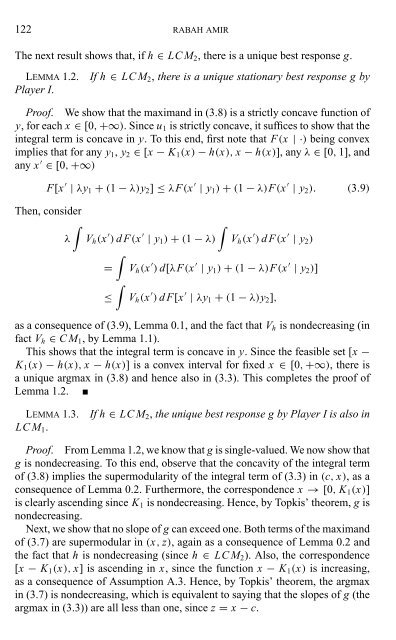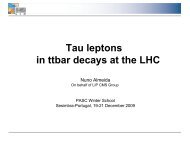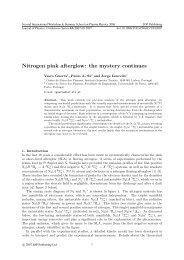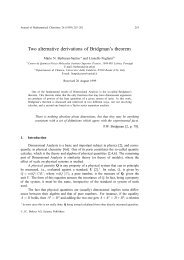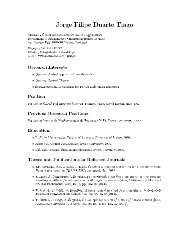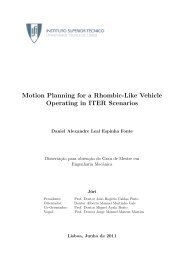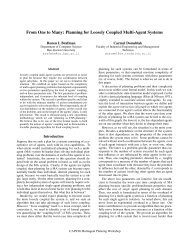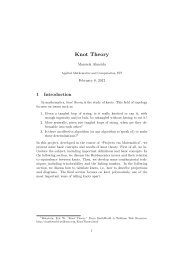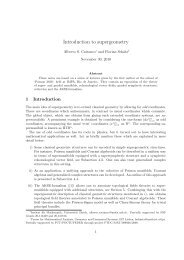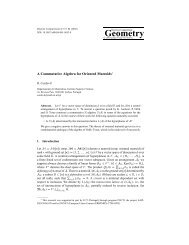Cournot Oligopoly and the Theory of Supermodular Games
Cournot Oligopoly and the Theory of Supermodular Games
Cournot Oligopoly and the Theory of Supermodular Games
Create successful ePaper yourself
Turn your PDF publications into a flip-book with our unique Google optimized e-Paper software.
122 RABAH AMIRThe next result shows that, if h ∈ LCM 2 , <strong>the</strong>re is a unique best response g.LEMMA 1.2.Player I.If h ∈ LCM 2 , <strong>the</strong>re is a unique stationary best response g byPro<strong>of</strong>. We show that <strong>the</strong> maxim<strong>and</strong> in (3.8) is a strictly concave function <strong>of</strong>y, for each x ∈ [0, +∞). Since u 1 is strictly concave, it suffices to show that <strong>the</strong>integral term is concave in y. To this end, first note that F(x |·)being conveximplies that for any y 1 , y 2 ∈ [x − K 1 (x) − h(x), x − h(x)], any λ ∈ [0, 1], <strong>and</strong>any x ′ ∈ [0, +∞)F[x ′ | λy 1 + (1 − λ)y 2 ] ≤ λF(x ′ | y 1 ) + (1 − λ)F(x ′ | y 2 ). (3.9)Then, consider∫λ∫V h (x ′ ) dF(x ′ | y 1 )+(1−λ)∫=∫≤V h (x ′ ) dF(x ′ | y 2 )V h (x ′ )d[λF(x ′ | y 1 )+(1−λ)F(x ′ | y 2 )]V h (x ′ ) dF[x ′ | λy 1 +(1−λ)y 2 ],as a consequence <strong>of</strong> (3.9), Lemma 0.1, <strong>and</strong> <strong>the</strong> fact that V h is nondecreasing (infact V h ∈ CM 1 , by Lemma 1.1).This shows that <strong>the</strong> integral term is concave in y. Since <strong>the</strong> feasible set [x −K 1 (x) − h(x), x − h(x)] is a convex interval for fixed x ∈ [0, +∞), <strong>the</strong>re isa unique argmax in (3.8) <strong>and</strong> hence also in (3.3). This completes <strong>the</strong> pro<strong>of</strong> <strong>of</strong>Lemma 1.2.LEMMA 1.3.LCM 1 .If h ∈ LCM 2 , <strong>the</strong> unique best response g by Player I is also inPro<strong>of</strong>. From Lemma 1.2, we know that g is single-valued. We now show thatg is nondecreasing. To this end, observe that <strong>the</strong> concavity <strong>of</strong> <strong>the</strong> integral term<strong>of</strong> (3.8) implies <strong>the</strong> supermodularity <strong>of</strong> <strong>the</strong> integral term <strong>of</strong> (3.3) in (c, x), asaconsequence <strong>of</strong> Lemma 0.2. Fur<strong>the</strong>rmore, <strong>the</strong> correspondence x → [0, K 1 (x)]is clearly ascending since K 1 is nondecreasing. Hence, by Topkis’ <strong>the</strong>orem, g isnondecreasing.Next, we show that no slope <strong>of</strong> g can exceed one. Both terms <strong>of</strong> <strong>the</strong> maxim<strong>and</strong><strong>of</strong> (3.7) are supermodular in (x, z), again as a consequence <strong>of</strong> Lemma 0.2 <strong>and</strong><strong>the</strong> fact that h is nondecreasing (since h ∈ LCM 2 ). Also, <strong>the</strong> correspondence[x − K 1 (x), x] is ascending in x, since <strong>the</strong> function x − K 1 (x) is increasing,as a consequence <strong>of</strong> Assumption A.3. Hence, by Topkis’ <strong>the</strong>orem, <strong>the</strong> argmaxin (3.7) is nondecreasing, which is equivalent to saying that <strong>the</strong> slopes <strong>of</strong> g (<strong>the</strong>argmax in (3.3)) are all less than one, since z = x − c.


